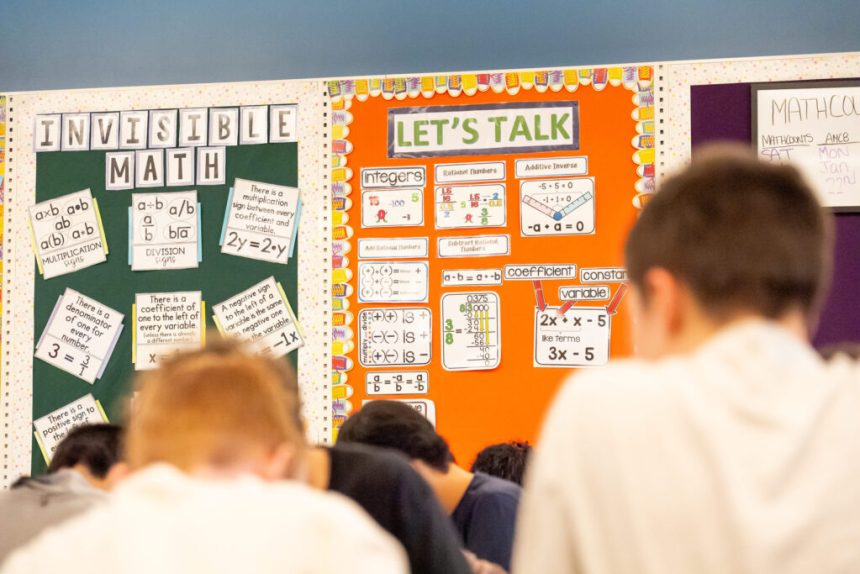Students work in a math class at Wasatch Junior High School in Salt Lake City on Tuesday, March 12, 2024. (Photo by Spenser Heaps for Utah News Dispatch)
Utah is the fifth-highest in the nation in the ranking of “focus on future generations,” a number largely driven by its high birth rates, which remain the highest in the nation. Also, by its strong effort to fund parks and recreation, according to a report from the Utah Foundation.
Nationally, birth rates are shrinking. So are investments in schools, parks and youth organizations. However, the issue is deeper in Mountain states, where the effort to establish a strong foundation for future generations is declining faster than the nation at large.
Even with a 60% decline since 2013, Utah is still a bit of an outlier in the region, the foundation says.
SUBSCRIBE: GET THE MORNING HEADLINES DELIVERED TO YOUR INBOX
“Utah is still fifth in the nation, and well above the national average in its focus on future generations,” Christopher Collard, research director of the Utah Foundation said in a statement. “However, the gap between Utah and the U.S. is closing.” That’s because of the state’s public school funding efforts.
Utah is typically last of all states in the widely used per-pupil spending numbers. But, for this study the Utah Foundation used a different education spending metric based on the state’s level of personal income. “This means that for every $1,000 earned by a Utahn, $37.91 was collected by a state or local government and spent on the K-12 education system in 2023,” researchers wrote.
With those metrics, Utah ranked thirds among the low-funding-effort Mountain states, the report says, spending $38 per $1,000 of personal income in 2023. That’s down from $58.52 in 2008.
All Mountain states have seen declines in their numbers since then. Idaho has the lowest spending effort, with $28 per $1,000 of personal income — down from about $40 in 2008. And, New Mexico, which at $51 was the highest ranked in the region, experienced a decline from about $60, according to the report.
The study also analyzed birth rates and funding efforts for parks and recreation, public schools and youth organizations since 2013, most of which have shrunk among Mountain states. These are trends that raise concerns, researchers said, because a gap in access to activities like team sports, means that many children may miss out on opportunities to build soft skills like grit and teamwork — and have reduced chances to build social connections.
Let us know what you think…
“While Utah is spending a lot on parks and rec, we continue to slide in public school funding effort,” Shawn Teigen, president of the Utah Foundation said in a statement. “We are blessed with a comparatively high, though declining, birth rate, but we are slipping further and further down on the other side of that coin – paying to educate those kids.”
What keeps Utah on top of the overall “focus on future generations” ranking is its “exceptionally large” families, something emblematic of the state’s culture, the report says.
“Family itself is a key source of social capital, with larger families often forming the threads for larger social networks. The built-in network of siblings, cousins, and other family members often allows for lifelong relationships that can help weave a large network of connections,” researchers wrote.
But, those exceptional numbers have been changing, and downward trends are most likely to continue.
In Utah, about 13 children are born per 1,000 residents, still the highest birth rate in Mountain West states, which have a median birth rate of 10 births per 1,000 residents. But, while all states in the region have seen declines in their birth rates, Utah’s numbers have decreased the most rapidly.
“Utah’s birth rate dropped rapidly from 2008 to 2023, from 21 births per 1,000 residents to a little over 13,” the study said. “This represents a major reconfiguring of Utah’s population that will manifest in countless ways during the coming years, in areas ranging from education to public health to employment.”













